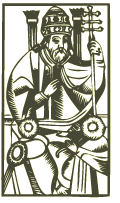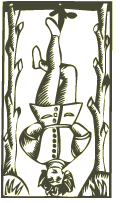 |

The Tarot has a fragmented history that intrigues historians, scholars, hobbyists, and spiritualists alike. Drawing on the concrete facts that are available, we will attempt to briefly explain the origins of the Tarot, and trace some of its milestones through the centuries.
The designs of the 22 cards in the Major Arcana can be traced back as far as 1440, when the first known deck appeared in Italy. The 3 decks called the "Visconti Trumps" are generally regarded as the "forefathers" of the decks that are widely available today. It is believed that they were originally created as a game for Nobles. It is not until centuries later that the cards reemerged, this time as a tool of divination. In the latter half of the 15th century, the cardmakers in Marseilles, France began to standardize the Trumps. Before this organized production, those who played the Trumps could dictate which they wanted to include, and which they wanted substituted or eliminated. Certain cards; Death, the Devil, and the Tower in particular; were considered offensive by the more conservative Nobles. These images caused religious leaders to attempt to ban the Trumps.
The first detailed reference to the Trumps of the Tarot is in the form of a sermon. This sermon, given by a Franciscan friar in Italy sometime between 1450 and 1470, contends that the Trumps were invented and named by the Devil. It condemns the use of the cards, and generally credits them with the triumph of the Devil. According to the friar, the Devil wins through the loss of the souls of those who play what was then, quite probably, nothing more than a simple game.
The rebirth of the Tarot, and its beginnings a means of divination, are attributed to Antoine Court de Gébelin in 1781.He believed it was Egyptian in origin, and that it contained mystical knowledge that had been purposefully encoded in the symbolism of the Trumps. Specifically, he theorized that the cards were the key to lost Egyptian magical wisdom written by Thoth, the Egyptian God of inspired written knowledge. The Trumps themselves began to noticeably evolve from this point forward. Changes were thought to have been introduced by the different secret societies who produced the decks.
The first account of divination through the use of cards is attributed to cartomancer Jean-Baptiste Alliette, better known as "Etteilla", in 1770. He was the first to publish divinatory meanings for cards, and only 32 cards (plus one, representing the querent) were included in this edition. At this time, only regular playing cards were mentioned. Later, Etteilla published several works that involved the Tarot Trumps specifically. It is no surprise that these later writings coincided with deGebelin's then-recently-public treatment of the Tarot as a wellspring of Egyptian occult knowledge. Etteilla must have anticipated the Tarot's jump in popularity: his was the first deck available to the public expressly for the purpose of Cartomancy.
The discovery of the Rosetta Stone that translated the hieroglyphs of the Egyptians in 1799 did not yield any support to the theory that the Trumps hailed from Egypt. Still, the belief endured and was augmented in 1857 with the introduction of the notion that the wandering Romany people - " Gypsies" thought to be descendants of Egyptians - had carried the deck with them on their travels through Europe.
In the nineteenth century, the famous occultist known as Eliphas Lévi developed a correlation between the Tarot and the Kabbalah: the Hebrew system of mysticism. This fueled a new belief that the Tarot originated in Israel, and contained the wisdom of the Tree of Life. The new theory brought all 78 cards together as keys to the mysteries, but again, there were no concrete facts to support it. Nevertheless, something important was accomplished. The theory would later serve as proof that the symbolism of the Tarot crossed all boundaries. From this point forward, many magical and esoteric groups recognized the Tarot as a timeless body of knowledge that had significance in every mystical path.
Since that time it has been linked with almost every magical system or religion known to humankind. The Tarot is comprised of archetypal images that cross linguistic, cultural, geographical, and temporal barriers.
The Theosophical Society, the Hermetic Order of the Golden Dawn, the Rosicrucians, the Church of Light, and the Builders of the Adytum (B.O.T.A.) all secured the Tarot's position in the 19th and 20th centuries. In the United States of America, the Tarot became popular and more readily available in the 1960's, when a period of exploration in spirituality began.

Arthur Edward Waite is credited with the renaissance of the Tarot in the Twentieth Century. He commissioned artist Pamela Coleman Smith to create what he called the "rectified" Tarot. Created by a member of secret societies also known as a revered mystic, Waite's version has been widely accepted as the standard, and is by far the most popular deck of the century, rich in symbolism and easily understood due to the simple nature of the artwork.
In the opinion of many learned Tarot enthusiasts, the most significant change the deck has experienced is Smith's treatment of the Minor Arcana. Hers are the first "pip" cards to contain images depicting the meaning of the cards. These graphics allow readers to explain the significance of each cards nuance to querents who, in most cases, have never encountered the cards before. This artistic trend can be traced through the majority of the decks produced after the Rider-Waite (1910), and Smith's influence is readily recognized, as many of the images echo her drawings.
Today's Tarot card designs reflect specific trends in sexuality, religion, culture, and philosophy. There are literally hundreds of interpretations, and more are being conceived as this is being written. The diversity of the styles allows Tarot Readers to choose a deck that suits their personalities, the subject of the reading, the person receiving the reading, or any other variable as they so choose. Certain decks have a serious tone, some have a dream-like quality, others are full of cartoon images. The true beauty lies in the Tarot's ability to retain its "soul" through each metamorphosis and incarnation. It is, on many levels, a mirror of those who work with it, and allows them to make each reading a truly personal experience.
|
 |





